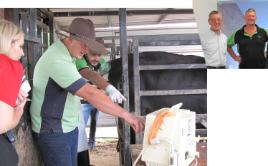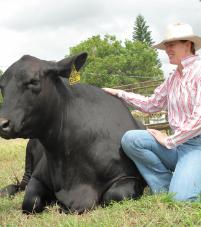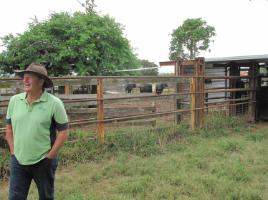Birth of calf expected after 'handmade cloning'
Published on 01 Nov, 2012
Media Contact: Interviews via Simon Walton on 0400 368 048For Immediate Release
Even though Dolly the Sheep was famously born back in 1996, traditional cloning has proven to be too expensive to be viable in the cattle industry. However, in 2001, Professor Gábor Vajta was involved with Dr Ian Lewis at the Monash Institute of Reproduction and Development, in the development of a ‘handmade cloning' technique.
A simple dissecting microscope and micro blade were used to dissect and reconstruct the embryo to effect 'somatic cell nuclear transfer', producing 10 calves.

Simon Walton points to a sonography screen used to track progress of the pregnancy. Inset: Professor Gábor Vajta (left) and Simon Walton
Click here to View/Download full-sized Image
On moving to Denmark, Prof Vajta further developed the technique, and after three years produced cloned pig embryos. These were the first cloned animals produced in Scandinavia. In 2004, Prof Vajta was involved in the production of the first cloned animal (cow) in Africa, produced under very compromised conditions in a small lab close to Pretoria.
But the technique was still very demanding, and consequently it has not progressed to widespread use.
More recently after taking on a position with CQUniversity, Prof Vajta has been working on a more viable handmade cloning technique in collaboration with local firm Australian Reproductive Technologies (based at Mt Chalmers near Rockhampton). He reports success with the very first attempt.
""It is like starting a car that has been in the garage for 10 years, and winning a Formula 1 race without oil change and tyre pressure adjustment. This result is extremely promising for the future large-scale application - my dream for 12 years," Prof Vajta says.
The result of the latest handmade cloning has been successfully implanted, with a pregnancy achieved on the second attempt and a calf due to be born in February.

Oaklands property owner Megan Hansen with the record-price cow that has been cloned
Click here to View/Download full-sized Image
ART Managing Director Simon Walton says the overall goal is to find the best way to commercialise cloning for the benefit of the cattle industry.
"Since Dolly the Sheep was produced from one of 273 embryos, cloning has not really taken off. The technique is still expensive at between $15,000-$30,000 per clone and the success rate has only improved to around 1 in 20," Mr Walton says.
"The new technique will continue at an experimental level for a while but longer-term the goal is a viable commercial, industrial application."

Simon Walton's all smiles after the sonography shows the pregnancy is on track
Click here to View/Download full-sized Image
ENDS

